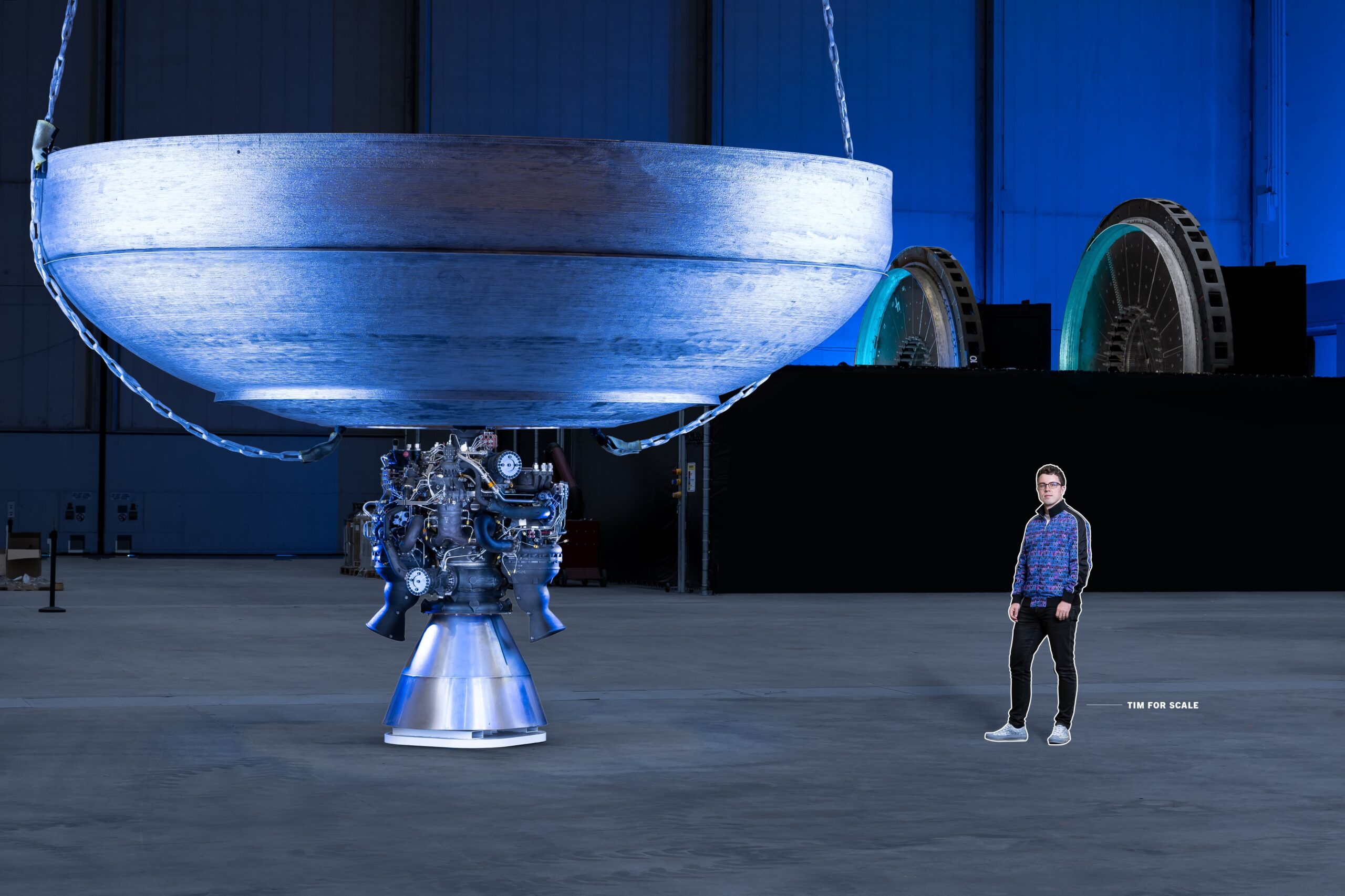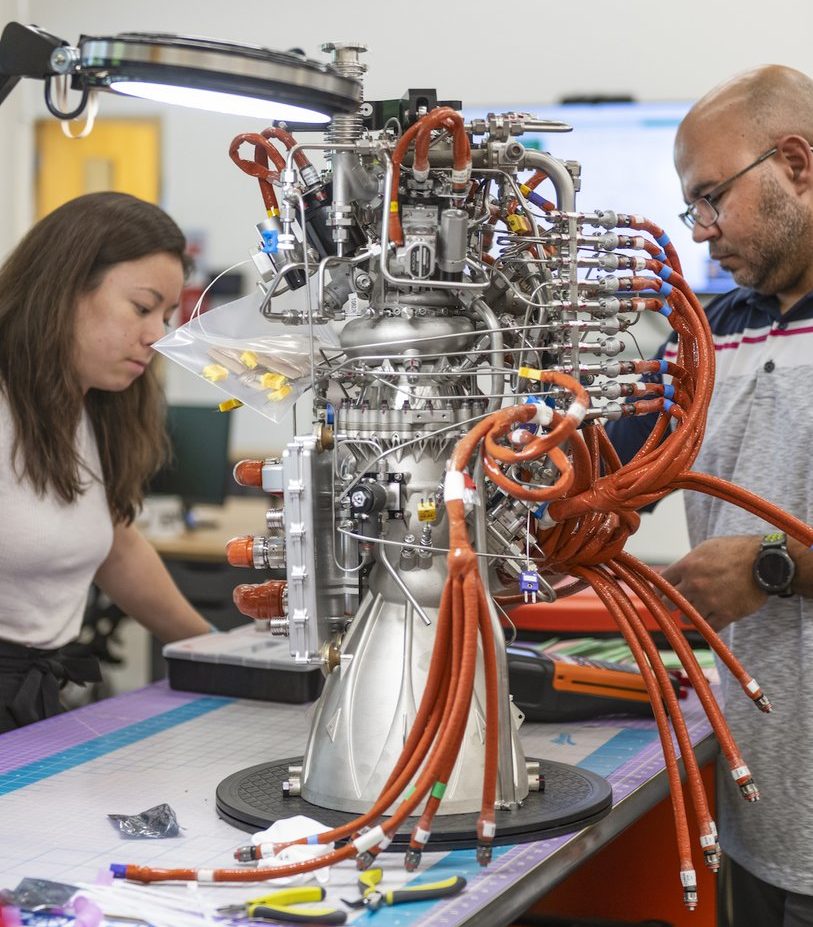In 2024, space exploration will reach new heights with a significant focus on lunar missions. The year will see the highly anticipated Artemis II mission, a milestone in NASA’s Artemis program, sending humans back to the Moon for the first time in 50 years where the crew will orbit the Moon during this historic trip. Alongside lunar missions, Europa Clipper is set to launch towards Jupiter’s Europa moon to study its habitability and search for signs of life. New spacecraft debuting include Blue Origin‘s New Glenn, a heavy-lift orbital launch vehicle for commercial satellite missions; the European Space Agency (ESA) ‘s Ariane 6, a more versatile and competitive successor to Ariane 5, and the UK’s Skyrora is set to make its first orbital journey early in 2024.
This year will also see the launch of several key projects under NASA’s Commercial Lunar Payload Services (CLPS) program, including Astrobotic Technology‘s Peregrine Lander, Intuitive Machines‘ Nova-C, and Firefly Aerospace‘s Blue Ghost, all aimed at delivering payloads to the Moon. Also, NASA’s VIPER rover will embark on a mission to explore water ice at the Moon’s South Pole. Complementing these efforts, the Japan Aerospace Exploration Agency (JAXA) ‘s Smart Lander for Investigating Moon (SLIM) will demonstrate advanced lunar landing technology, and China’s Chang’e 6 mission is set to conduct a groundbreaking lunar sample return from the far side of the Moon. Moreover, SpaceX’s Starship is scheduled for its third, fourth, fifth, and subsequent launches, marking a major leap in cost-effective and sustainable space travel, with ambitions extending to Mars missions.
As 2024 brings a wave of anticipated advances in space exploration, the role of 3D printing will be noteworthy and far-reaching. This approach to space exploration has already changed how we think about manufacturing in space, offering plenty of solutions that promise to make space missions more efficient and sustainable. As we look ahead to the vast potential of 3D printing in space exploration, let’s pause to appreciate the strides made in this innovative field throughout 2023. The year encapsulated the dynamic and challenging landscape of space exploration, from industry consolidations and ambitious ventures to innovative launches and the closure of a major space company.
Launcher’s Liftoff
In a significant move for space 3D printing, Vast, a pioneer in space habitats, acquired California-based small launch vehicle manufacturer Launcher. This acquisition combines Launcher’s expertise in developing high-performance rocket engines with Vast’s ambitious mission to create artificial-gravity space stations. Launcher has a track record of developing high-performance rocket engines using additive manufacturing (AM) giants like Velo3D (NYSE: VLD) and AMCM. This expertise in AM, combined with Vast’s mission to create artificial-gravity space stations, holds great promise for the future of 3D printing in space.
Vast’s ambitious goal is to build a 100-meter-long artificial-gravity space station capable of accommodating over 40 people in orbit. This project highlights the growing role of 3D printing in space exploration. Furthermore, Vast’s acquisition of Launcher clearly indicates how AM is becoming an integral part of advanced space technologies. As Launcher’s founder, Max Haot, assumes a leadership position within Vast, a talented team of over 120 employees will collaborate to make this vision a reality, combining their expertise in rocket engineering and 3D printing.

Launcher’s Orbiter SN1 integration has started in the clean room facility. Image courtesy of Launcher via LinkedIn.
Virgin’s Voyage End
Virgin Orbit, once valued at $3.7 billion and trading on the Nasdaq, faced a bleak outcome in 2023 as it filed for Chapter 11 bankruptcy and ceased operations. This development is disheartening, especially considering the company’s initial promise in the 3D printed space hardware arena. Virgin Orbit’s struggles came to a head following a failed launch attempt in January, where its LauncherOne rocket experienced an anomaly, resulting in a premature shutdown and failure to reach orbit.
Despite incorporating 3D printing into its rocket manufacturing process and experiencing some successes, such as reducing engine manufacturing cycle times by tenfold, Virgin Orbit couldn’t secure the long-term funding needed to recover from its setbacks. The company’s stock price plummeted by over 90% between December 2022 and March 2023, signaling a challenging period for the space industry. Virgin Orbit’s difficulties highlight the competitive nature of the space startup scene and the importance of securing consistent funding and reliable rocket launches.
In a broader context, Virgin Orbit’s struggles are part of a larger trend in the space industry, where several startups, including those leveraging 3D printing technologies, have faced difficulties delivering rockets to orbit. This challenging landscape, coupled with tech layoffs and outsourcing in the aerospace sector, points out the complex dynamics in the evolving space exploration landscape.
Relativity’s Rocket Revolution
And talking about rockets in orbit, last March, Relativity Space launched the world’s first 3D printed rocket named “Good Luck, Have Fun” (GLHF). Standing 110 feet tall, the Terran 1 rocket took off from Cape Canaveral in Florida after overcoming two previous launch attempts. While successful, the rocket failed to reach orbit due to an “anomaly” in the second stage. Despite this setback, the successful launch was a significant achievement for Relativity Space and the AM industry.
What sets the Terran 1 rocket apart is that it was constructed using Relativity’s robotic directed energy deposition (DED) system called Stargate, which is considered the world’s largest metal 3D printer. Roughly 85% of the vehicle comprises 3D printed components. Relativity’s approach, utilizing DED for large-scale 3D printing, could impact the aerospace industry and manufacturing in general. With the potential to apply this technology to missile production, submarine hulls, and aircraft fuselages, Relativity’s achievements highlight the broader implications of 3D printing beyond space exploration.

Terran R infrastructure is being 3D printed in Long Beach, California. Image courtesy of Relativity Space via Twitter.
As part of a strategic shift, Relativity decided to discontinue its Terran 1 small launch vehicle in April, following its failed launch attempt in March. The company’s focus is now on serving the heavy end of the market, with Terran R capable of placing up to 5,500 kilograms into geostationary transfer orbit while recovering the first stage. Relativity has ambitious plans for its Terran R rocket, aiming for a debut launch no earlier than 2026. Founder Tim Ellis emphasized the need for more competitive, diversified, and disruptive launch capacity in the space industry. Terran R is being developed as a customer-focused reusable launch vehicle to address this demand.
Alliance in Orbit: Agile & 6K
In 2023, Agile Space and 6K Additive joined forces to advance space technology through superalloy 3D printing, particularly for critical rocket components. Agile will certify and use 6K Additive’s Nickel 625 (Ni625) powder in its manufacturing facility for 3D printing components, starting with Agile’s A2200 bipropellant hypergolic engine. This engine uses a special fuel called hydrazine, allowing it to operate without a traditional ignition spark. Agile’s rapid development cycle, enabled by AM, has reduced aerospace component development timelines to just 12 months. The A2200 engines, incorporating 6K Additive’s Ni625 powder, are designed for lunar lander vehicles, offering precise control and maneuverability for lunar missions.

6K Additive’s Ni625 powder is being certified for use with Agile’s A2200 bipropellant hypergolic engine. Image courtesy of 6K Additive.
Ursa’s Propulsive Breakthrough
2023 was a big year for 3D printed rocket engine maker Ursa Major. The Colorado-based startup secured funding, partnered with America Makes and shared its new process for 3D printing solid rocket motors (SRMs). One of its standout achievements was successfully raising $138 million in a Series D round. The cash will support the development of Ursa Major’s Lynx platform, which is designed for modular 3D printing of SRMs. The Lynx platform addresses critical gaps in the nation’s defense by providing urgently needed capabilities, such as producing smaller, man-portable SRMs like those used in missiles like Stingers and Javelins.
Moreover, Ursa Major’s strategic partnership with America Makes also plays a vital role in accelerating the transition from prototyping to production and promoting the commercialization of IP realized through federal spending, contributing to developing new standards for US domestic manufacturing in space hardware and beyond. The collaboration, initiated in 2021, established the Ursa Major Advanced Manufacturing Lab, thanks to $3 million in federal funding. In 2023, the partnership was extended through mid-2024, enabling Ursa Major to expand its capabilities. The partnership also aligns with the broader goals of the Biden administration’s executive order on federally-funded R&D and domestic manufacturing, aimed at enhancing manufacturing capacity and bolstering national security.

Turbo design engineer Stephanie Gavell (L) and build operations manager Chaka Smith (R) assembling one of Ursa Major’s Hadley engines. Image courtesy of Ursa Major via Twitter.
Advances in 3D printing, as witnessed in various space projects, demonstrate the technology’s potential to help shape the future of space exploration. This theme will be further explored at the Additive Manufacturing Strategies (AMS) 2024 summit, set to take place from February 6-8 in New York City. A key event in the AM industry, AMS 2024 will cover topics from AI and material science to industrial AM strategies. Highlighting this focus, the summit will feature panels including “Space Exploration using AM” with NASA’s Paul Gradl and “The Industrialization of Additive for Aerospace” with experts from Maxar Space and MIMO Technik. Attendees can expect to engage in enriching discussions and gain insights into how these technologies are driving the future of space exploration and beyond.
Subscribe to Our Email Newsletter
Stay up-to-date on all the latest news from the 3D printing industry and receive information and offers from third party vendors.
Print Services
Upload your 3D Models and get them printed quickly and efficiently.
You May Also Like
Heating Up: 3D Systems’ Scott Green Discusses 3D Printing’s Potential in the Data Center Industry
The relentless rise of NVIDIA, the steadily increasing pledges of major private and public investments in national infrastructure projects around the world, and the general cultural obsession with AI have...
Formlabs Teams Up with DMG MORI in Japan
In late June, Nick Graham, Chief Revenue Officer at Formlabs, announced on LinkedIn that the company had partnered with DMG MORI, one of the world’s leading machine tool companies, to...
EOS in India: AM’s Rising Star
EOS is doubling down on India. With a growing base of aerospace startups, new government policies, and a massive engineering workforce, India is quickly becoming one of the most important...
3D Printing News Briefs, June 25, 2025: R&D Materials, 3D Printed Veneers, & More
In today’s 3D Printing News Briefs, 3DXTECH has launched a program that gives customers early access to experimental materials, and the first Lithoz CeraFab Multi 2M30 in the Czech Republic...



































